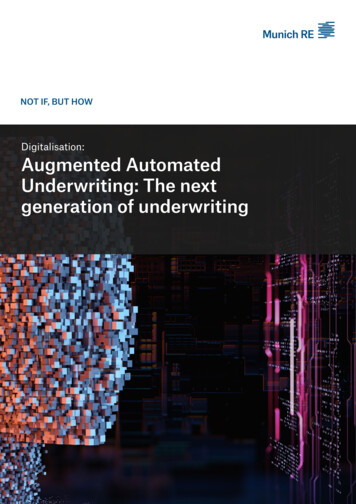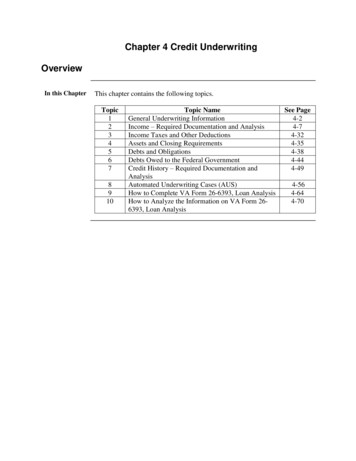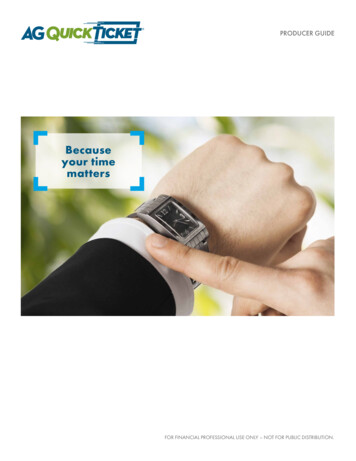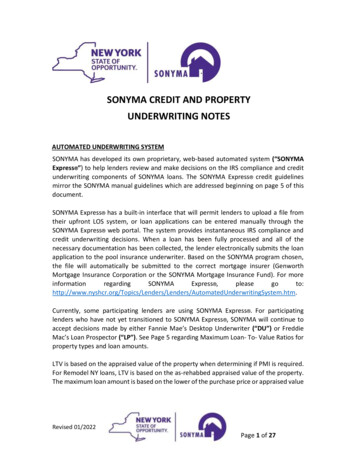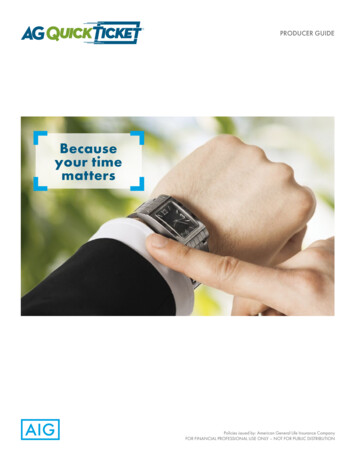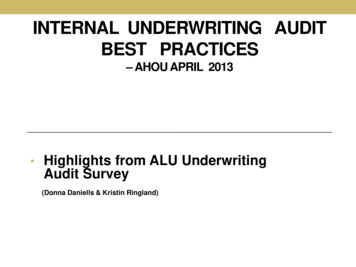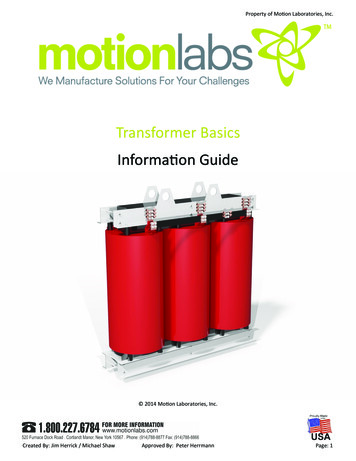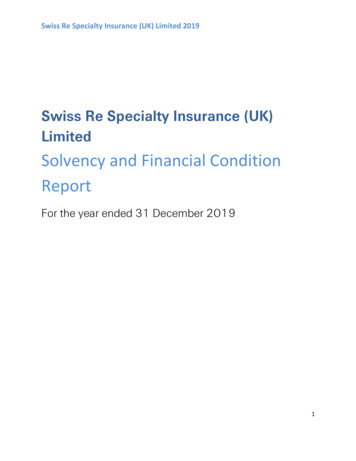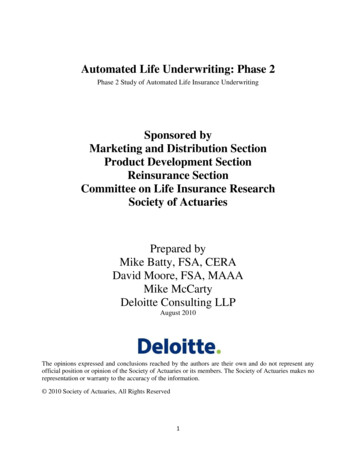
Transcription
Automated Life Underwriting: Phase 2Phase 2 Study of Automated Life Insurance UnderwritingSponsored byMarketing and Distribution SectionProduct Development SectionReinsurance SectionCommittee on Life Insurance ResearchSociety of ActuariesPrepared byMike Batty, FSA, CERADavid Moore, FSA, MAAAMike McCartyDeloitte Consulting LLPAugust 2010The opinions expressed and conclusions reached by the authors are their own and do not represent anyofficial position or opinion of the Society of Actuaries or its members. The Society of Actuaries makes norepresentation or warranty to the accuracy of the information. 2010 Society of Actuaries, All Rights Reserved1
.Automated Life Underwriting: Phase 2Phase 2 Study of Automated Life Insurance UnderwritingContentsExecutive Summary .3Project Overview .4Study Method .6Results and Analysis .7I. Applications of Automated Underwriting . 7II. Operational Efficiency .13III. Sales .17IV. Risk Selection and Claims Experience.18V. Unexpected Challenges and Benefits .19VI. Cultural Acceptance.21Conclusions.23Appendix A: Acknowledgments.25Appendix B: Automated Underwriting Discussion Outline .26 2010 Society of Actuaries, All Rights ReservedPage 2
Automated Life Underwriting: Phase 2Phase 2 Study of Automated Life Insurance UnderwritingExecutive SummaryMany life insurance companies are turning to technology to speed and remove cost from theunderwriting process. Automated underwriting systems have been developed to reduce the manpower,time, and/or data necessary to underwrite a life insurance application while maintaining the quality ofunderwriting decisions.In the fall of 2009, the Society of Actuaries’ (SOA) Marketing and Distribution Section Council, theProduct Development Section Council, and the Committee on Life Insurance Research engaged DeloitteConsulting LLP (Deloitte) to conduct a survey investigating the role of automated underwriting in theindustry. The study revealed that life insurers have a strong desire to improve the efficiency ofunderwriting, and while the penetration of automated underwriting is still relatively low, there issignificant interest in its potential. The study also found life insurers who are using automatedunderwriting generally believe the systems are beneficial to their organizations. Despite some concernswith the technical and other implementation and maintenance challenges, life insurers surveyed believethey are improving the efficiency of underwriting. In fact, even insurers who are less satisfied with theirown system would choose to pursue a different automated underwriting solution rather than forgo theidea altogether. The full results of the study are documented in the SOA report, “Automated LifeUnderwriting.”In the Spring 2010, the SOA engaged Deloitte to conduct a follow-up study. While the initial studyutilized a web-based survey to capture a broad view of automated life insurance underwriting, theinterview format of the Phase 2 research allowed a deeper look at the role of automation within a selectnumber of companies. This report presents the interview findings through illustrative descriptions of lifeinsurers’ experiences with automated underwriting. Specifically, this report discusses:How and why companies are using automation to make underwriting decisionsIts impact upon operational efficiency, sales, and retentionThe quality of risk selection produced by automated systemsCultural acceptance of increased automation in underwritingChallenges insurers must overcome to implement and maintain automated underwritingWhile this report details many examples of life insurers’ experiences with automated underwriting, thestudy also motivates several broad observations about which companies are more or less successfulwith automated underwriting. First, automated underwriting has become a genuine success for somelife insurers. These companies were among those using automated underwriting for simplified issue andnon-medical underwriting, and to a slightly lesser degree, for flagging pieces of information in theunderwriting process for review by an underwriter. In particular, several multiline insurers have foundthe advantages of automated underwriting very compelling for selling small- to medium-sized policies 2010 Society of Actuaries, All Rights ReservedPage 3
through agents who do not specialize in life insurance. In contrast, life insurers in the study experiencingless success are among those attempting to replicate medical underwriting with an automated system.These firms are more likely to find that an overwhelming amount of work is necessary to implement andmaintain automated underwriting, only to be disappointed when human underwriters are still calledupon to review many applications.Regardless of how insurers are using automated underwriting, those interviewed expressed a highdegree of confidence in their ability to select risks and maintain acceptable claims experience. Throughaudits of sample cases, firms believe that automated underwriting is as or more consistent than humanunderwriters in interpreting the information contained within the underwriting requirements for whichthey are designed.These experiences are not entirely uniform. Both complaints and statements of support were made forautomated underwriting by companies using it in each context. However, as an overall trend, usingsystems to automate portions of the underwriting process to which it is best suited, such as simplifiedissue, non-medical underwriting, or monitoring acceptable ranges for individual requirements, is a keyto success. Underwriters often have concerns about increased automation, but they are generallyaccepting when they come to understand these targeted uses of automated underwriting allow them tofocus their energy on more complex cases where human judgment is most valuable. Representativesfrom marketing departments typically support automated underwriting, and the response of agents ismixed.Project OverviewRigorous underwriting protects life insurers from taking undue risks, but it also adds considerableexpense to the bottom line, and is often cited as a barrier for underserved populations to becomeadequately insured. The industry continues to search for methods to underwrite individual applicants inways which are less invasive and more cost and time effective, yet still maintain sufficient rigor. Manylife insurance companies see technology as a solution. In order to speed and remove cost from theunderwriting process, they are turning to automated underwriting systems which interpret datatraditionally reviewed by underwriters.In the fall of 2009, the SOA’ Marketing and Distribution Section Council, the Product DevelopmentSection Council, and the Committee on Life Insurance Research engaged Deloitte to conduct a surveyinvestigating how automated underwriting is being used in the industry. The web-based survey captureda broad view of how many companies are using or are interested in automated underwriting, why theyare using it, and their level of satisfaction. The findings are presented in a SOA report entitled“Automated Life Underwriting” released in early 2010. Throughout this report, this research will bereferred to as “Phase 1.”To develop a more detailed understanding of how life insurers are using automated underwriting theSOA asked Deloitte to conduct interviews with a subset of companies from Phase 1 that are using these 2010 Society of Actuaries, All Rights ReservedPage 4
systems.1 Phase 1 took a snapshot of many companies and produced a standard and easily comparabledata set, but many details of an individual company’s experience can be lost through this format ofcommunication. Although it lacks the uniformity and ability to automatically produce data for analysis,an interview approach was selected for this follow-up study (Phase 2) as the best method to fullyunderstand how each company is using automated underwriting. A summary of the varying studyapproaches is provided in Table 1.Table 1: Summary of Possible Study DesignsMortality StudySurveyProsDelivers concrete,quantifiable result aboutthe ability of automatedunderwriting to selectrisks.Many companies canparticipate at low cost.Standard questionformat.Large dataset for analysis.ConsCompanies have limitedmortality experience anddata to share.Different approaches toautomated underwritingmake inter-companydata difficult to compare.Unique experiences ofindividual companies arehard to communicate.SummaryAlthough intriguing, amortality study is notfeasible at this time.Another survey wouldhave limited ability touncover additionalinformation after Phase 1.Live InterviewClear understanding ofeach company’s situationand experience.Companies can raiseissues not anticipated inresearch design.Time requirements limitstudy participation.Unique character of eachinterview limitscomparability.Less concrete data isgathered throughinterviews.Interviews provide thebest method ofdeveloping a deeperunderstanding of eachcompany’s experience.The ultimate goal of the Phase 2 research was to develop illustrative examples of how and why lifeinsurers are experiencing more or less success with automated underwriting. Specifically, the interviewsfocused on the following topics:Purpose of automated underwriting, i.e., how it fits into each insurer’s business goals1The initial goal of the follow-up study was to gather data from companies using automated underwriting andconduct a mortality study. However, Phase 1 revealed that too few companies have the requisite mortalityexperience and data for policies underwritten automatically to share for a robust study. In addition, the differentways in which life insurers are applying automation in the underwriting process makes comparing mortalityexperience difficult. In lieu of a mortality study, the project oversight group decided that the best way to furtherstudy automated underwriting at this time would be to conduct interviews with a subset of companies from Phase1 that is using these systems. 2010 Society of Actuaries, All Rights ReservedPage 5
Any operational efficiencies it producesIts impact upon insurance salesQuality of risk selection and claims experience from automated underwritingAny unexpected challenges and benefitsCultural acceptance of automated underwritingBecause life insurers utilize technology for underwriting in different ways, it is important to first clarifywhich type of system is analyzed here. For the purposes of this study, automated underwriting system isdefined as follows:Automated Underwriting System: a technology solution which is designed to perform all orsome of the screening functions traditionally completed by underwriters, and thus seeks toreduce the manpower, time, and/or data necessary to underwrite a life insurance application.Rather than focusing on any particular approach to automated underwriting, interviews covered alltechnologies and methodologies which meet this basic definition. Although they also aim to improveunderwriting efficiency, systems whose main functions are to replace paper forms with electronic dataand otherwise manage the workflow but do not interpret any of the information upon whichunderwriting decisions are made, are not covered in this report.Study MethodData was gathered for this study through phone interviews with representatives from companies usingautomated underwriting. The representatives from each company were selected on the basis of theirknowledge of the company’s automated underwriting process. These individuals were primarilyunderwriters, but actuaries, claims managers, and other personnel also participated in some interviews.The participating companies were selected from the respondents of the original web-based surveyreferenced above. The 24 survey participants using automated underwriting were invited to interviewsessions to discuss their experience with automated underwriting. Fourteen companies accepted theinvitation and participated in this study. These organizations agreed to participate on the condition ofanonymity.A discussion outline was used to structure the interviews. This document was distributed to the surveyparticipants in advance and walked though during each interview. It helped provoke discussion aboutthe topics of interest, but was not an explicit script for the session. Moreover, the discussions weretailored to best fit the unique experience of each company. For example, participants were first asked todescribe any savings or additional costs resulting from automated underwriting. If the response aboutcost savings warranted further discussion, the interview would continue to explore how the cost savingswere generated, their magnitude, how they compared to expectations, etc. Participants were also giventhe opportunity to raise any issues associated with automated underwriting they felt are important, butwere not covered in the discussion outline. The outline was designed for an hour long conversation andwas divided into the sections bulleted above in the Project Overview section of this report. A copy of the 2010 Society of Actuaries, All Rights ReservedPage 6
discussion outline is presented in Appendix B. Information gathered through these interviews andsubsequent clarifying discussions are the basis for the following results and analysis.Results and AnalysisBecause interviews following an outline rather than a script were used to gather information in Phase 2,the study did not result in a uniform dataset as was produced in Phase 1. Instead, the goal of theinterviews was to communicate elements of each company’s experience with automated underwriting,which could not be understood as clearly through the survey responses. As a result, this report primarilypresents examples of issues participating life insurers have encountered, and makes observations aboutgeneral trends, but does not significantly use statistical data analysis. Also, because Phase 2 focusedmore deeply on a small participant population; this report does not attempt to be representative of thelife insurance industry overall. The results and analysis presented here are organized based on theaforementioned discussion outline.I. Applications of Automated Underwriting – Different ways life insurers are using automationto improve their underwriting processesIt was clear from Phase 1 that different companies are using automated underwriting for differentreasons. The data showed that while rules-based underwriting systems are predominant, there are wideranges for how much of each company’s business is handled by the automated underwriting system,how often the system is able to make or recommend underwriting decisions, whether or not age andamount restrictions are placed upon policies using the automated process, and what capabilities thesystems have. For example, see the following tables and figures described in the Phase 1 report thatshow automated underwriting systems used by different companies taking different types of actions(Table 2), reaching decisions with varying frequency (Table 3), and allowing systems permission to issueat different underwriting classes (Figure 1).Table 2: Systems Abilities to either Reach or Recommend an Underwriting Decision (Phase 1 – Table 4)Does the system have the ability to?Both reach a final and recommend an underwriting decision54%Reach a final, but not recommend an underwriting decision25%Recommend, but not reach a final underwriting decision13%Neither reach a final nor recommend an underwriting decision8% 2010 Society of Actuaries, All Rights ReservedPage 7
Table 3: Actions Taken by Automated Underwriting Systems (Phase 1 – Table 7)How often does the system?AverageStDevRangeReach a final underwriting decision withoutunderwriter review?41%39%100%Recommend an underwriting decision for anunderwriter to review?15%22%73%Fail to reach or recommend an underwriting decision(due to data errors, complexity, or otherwise)?44%41%100%Figure 1: Combinations of Risk Classes Available to Automated Systems (Phase 1 – Figure 8)Standard andPreferred throughsubstandardsubstandard4%4%Ultra and preferred4%All classes18%Standardthrough decline13%Standard orbetter18%Standard only39%The first goal of the Phase 2 interviews was to develop a better understanding of what each company ishoping to accomplish with automated underwriting. The discussions about how life insurers are usingautomation revealed three general categories of underwriting systems. The three categories varyprimarily in the amount of autonomy given to the system.Alerting Underwriters to Risk FactorsThe first class uses automation to flag items in the underwriting process that an underwriter mustreview more carefully. For example, a blood chemistry profile of an applicant will be submitted to theinsurer, data will be loaded into the system, and user-defined logic will determine the cholesterol level isout of range. This information, and any other items in the underwriting process exceeding theacceptable boundaries, will be included in a report to a human underwriter. The underwriter then useshis or her judgment and knowledge of the underwriting guidelines to make an underwriting decision. 2010 Society of Actuaries, All Rights ReservedPage 8
Using automation to alert underwriters of risk factors rather than attempting to make fully automatedunderwriting decisions has both advantages and drawbacks. The logic embedded in a life insurer’sunderwriting manual instructs an underwriter not only how to react to each individual risk factor, butalso how to react to a combination of risk factors. Since this logic does not need to be fully developed insystems only flagging outlying pieces of information, an underwriter still must manually review files forall but the least risky applicants. However, because this logic is not required, the systems are mucheasier and less expensive to implement and maintain. In general, the companies participating in thisresearch found the development and maintenance of systems such as these to be challenging, butconsiderably less so than the others described below.The underwriting systems designed to flag information for underwriter review are able (either currentlyor with further customization) to process any underwriting requirement that is delivered in a databaseformat. For many companies, requirements which are screened automatically include reflexive orstandard application and exam questions, MIB, MVR, Rx databases, and lab results. Generally, if aparticular company is not currently using the automated system to analyze each of these requirements,they expressed interest in building that functionality in the future. Since they are not adaptable to adatabase format, attending physician’s statements (APS) and other types of medical requirementsremain outside of the automated underwriting screen. However, even if they do not process the results,these types of automated underwriting tools are sometimes given the authority to order themautomatically through a direct link with the appropriate vendor.Automation for Simplified Issue and Non-Medical UnderwritingA second class of automated underwriting system is designed to complete simplified or non-medicalunderwriting for smaller face amounts (often up to 100,000 or 250,000). They capture a limited set ofunderwriting requirements that take less time and resources to acquire, interpret the informationreceived, and make an underwriting decision for most cases in a short period of time. The set ofrequirements processed varies slightly, but usually includes some combination of an application (eithershort-form, traditional, or reflexive questions), MIB, MVR, and Rx database. Depending upon thebusiness strategy for the product, the underwriting system can make a simple accept/reject decision onthe applicant, place the applicant into a standard, smoker or in some cases a preferred category, or referthe individual for further underwriting. Because of the limited set of requirements gathered, the lifeinsurers participating in Phase 2 using this type of system generally do not feel they have sufficientinformation to perform underwriting with the granularity of traditional underwriting. For example,products in this market are sometimes designed to group standard and preferred classes into a singlerisk class, and companies do not use this process to rate substandard risks. Some companies will referwhat appear to be higher risk cases to human underwriters who will potentially order additionalrequirements, while others will simply decline to offer insurance through this process.For companies in this study, the times in which decisions are rendered for simplified-issue and nonmedical underwriting applications vary from a few seconds to several days. Some are designed to betrue instant issue processes where an application is taken electronically and requirements are orderedand delivered automatically allowing for very rapid underwriting decisions. Other companies placing aslightly lower premium on speed, can take applications via paper or schedule a call-back interview, but 2010 Society of Actuaries, All Rights ReservedPage 9
still make underwriting decisions in less time than is typical for a traditional, human-driven underwritingprocess.In addition, the percentage of business submitted for which these systems are able to completeunderwriting varies from company to company, but is generally quite high, with a typical decision ratebeing 80 percent (either rejecting or making an offer). One company in the study is able to achieve arate as high as 95 percent. The variance depends upon both the individual company’s tolerance forunderwriting risk as well as the sophistication of the system coding. Some firms rely upon their systemto interpret cases which are less clear cut, while others have empowered them to handle more complexissues. For example, some firms have attempted to provide rules for how nearly every possiblecombination of risk factors results in an underwriting decision, while others have made a smallerinvestment in rules development knowing that more cases will require expert human judgment. Thepolicies for which a decision cannot be made are turned over to an underwriter who may determineadditional requirements are necessary.In the experience of the study participants, designing an underwriting system to make or recommendunderwriting decisions requires significant time and resources to build and maintain. Instead of simplyflagging information that is potentially pertinent, the system must determine how all availableinformation translates into an underwriting decision. In addition to the infrastructure required to linkthe necessary data sources and systems, coding the necessary logic is a large undertaking. However,because the decisions are based upon a limited set of underwriting requirements, coding these systemsis less cumbersome than those that underwrite larger policies.Also, due to the markets and distribution forces often employed by multiline insurers, automatedunderwriting for rapid issue of smaller (often less than 100,000 or 250,000) policies has beenparticularly popular. The appeal of this strategy will be discussed further in subsequent sections of thisreport.Automation of Paramedical and Medical UnderwritingThe third and final category of automated underwriting that is employed by the Phase 2 participants isusing a system to assist with paramedical and medical underwriting. Companies studied in Phase 2 usingthis approach essentially translate their underwriting manuals into programmed rules in an automatedsystem. Applicants complete a full application with reflexive questions (possibly through a teleinterview) and undergo the company’s standard age and amount requirements. Instead of asking ahuman underwriter to assess the requirements, the rules-based system interprets the information andassigns an underwriting class. Phase 2 participants employing this approach are typically usingautomation to process the application, MIB, MVR, Rx databases, and lab results. If an APS or furtherrequirements are necessary, the case will kick-out of the automated system for a review by anunderwriter. In some automated systems, rules are coded to determine when an APS or other testsshould be ordered for cause. Age and amount limits are often used, but when in place, the limits for thisunderwriting are significantly higher than the limits for simplified issue products. In most cases,applicants can be underwritten into the full range of underwriting classes offered by the companythrough the automated process. 2010 Society of Actuaries, All Rights ReservedPage 10
Because a significant number of applicants do require an APS, data errors occasionally do occur fromimproperly executed electronic and tele-applications, and cases are sometimes too complex to behandled by existing rules. Many companies using these systems have found they are able to directlyissue a significantly smaller fraction of policies than the users of automated underwriting for smallerpolicies. Exceeding one-third of policies issued directly by the system proves challenging. Since manycases do need underwriter review it is very helpful if the system produces a clear and concise report forcases that are referred to underwriters. One life insurer expressed frustration that its particular systemdid not provide such information and underwriters were forced to hunt for the offending pieces of data.In its view, this materially reduced the potential speed with which cases can be underwritten.In the opinions of study participants, these full-scale automated underwriting systems are also the mostchallenging undertakings. They encompass all the coding and systems development described forsimplified issue and non-medical underwriting, but on a scale large enough to contain a full underwritingmanual. These systems have a broad array of functionalities, including:Processing medical lab tests;Processing more developed reflexive applications (which provide greater detail intoimpairments);Understanding rules to the extent they can assign debits and credits;Potentially assigning substandard ratings; and,Determining situations where additional medical requirements are necessary.Several companies interviewed expressed concerns about the feasibility of maintaining a systemrequiring thousands of rules to capture the complex workings of their underwriting process. 2010 Society of Actuaries, All Rights ReservedPage 11
SummaryTable 4 below presents a summary of the different uses of automated underwriting covered in Phase 2.Table 4: Summary of automated underwriting uses among study participantsMakes UWdecisionSize of PoliciesFlag out-of-range risk factorsfor underwriterComplete simplified andnon-medical underwritingComplete paramedical andmedical underwritingNeverFor most applicantsFor the minority of applicantsSmall to medium. Often lessthan 100,000 or 250,000.All for some insurers, whileothers exclude large faceamounts (e.g. greater than 2million)AnyProsEasier to implement andmaintain.Allows underwriters tofocus upon importantinformation.Challenging, butmanageable to implementand maintain.Completes underwriting formany applicants.Very popular for certainmarkets.Can essentially replaceunderwriters for a subset ofrelatively large policies.Can drive ordering ofrequirements for cause.Can provide reasons whypolicies are referred to anunderwriter.ConsUnderwriter reviewnecessary for everyapplicant.Only applicable for smallerpolicies.Many applications stillrequire underwriter review.Very costly to implementand maintain.84Phase 2Companies4Although we make no assumptions that the approaches to automated underwriting identified in thisstudy encompass all that exist in the life insurance industry, or are necessarily representative infrequency, we feel it is helpful to document their frequency among the participants of Phase 2. Eightparticipating life insurers are using automated underwriting for simplified issue or non-medicallyunderwritten products. Four are using systems to flag items in the underwriting process for theunderwriter to review, and four are using it to assist with traditional fully underwritten products. Asthere are 14 participants in the study there is slight overlap with two insurers applying a combination ofthe strategies above. One company is using a system for simplified issue and another for fullyunderwritten products, while another company is using automation for simplified issue and a flagapproach for larger cases. 201
Automated Underwriting System: a technology solution which is designed to perform all or some of the screening functions traditionally completed by underwriters, and thus seeks to reduce the manpower, time, and/or data necessary to underwrite a life insurance application. Rather than focusing on any particular approach to automated underwriting .
